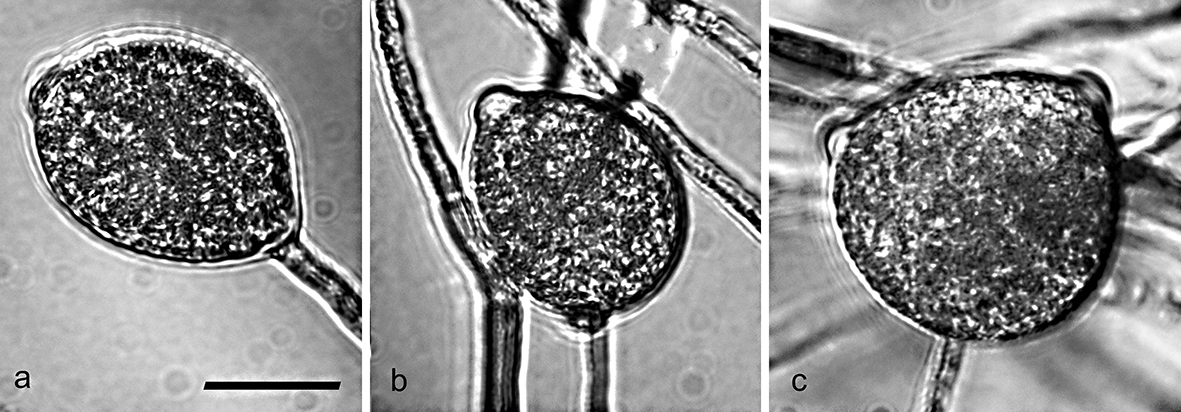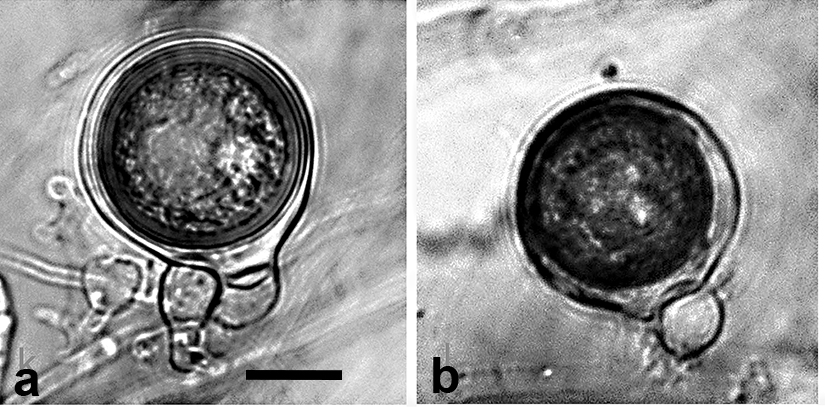Phytophthora condilina
|
Phytophthora spp. in subclade 6a: portion of the seven-loci ML phylogeny featuring the type cultures of 212 described species (by T. Bourret). Notice the position of P. condilina Ex-type CBS 143059 = S&T BL 184. Gloria Abad, USDA S&T.
|
|
Phytophthora spp. in subclade 6a: Morphological Tabular key (PDF) and Tabular key legends (PDF) in IDphy2 KEY SECTION. Notice the data of P. condilina Ex-type CBS 143059 = S&T BL 184. Gloria Abad, USDA S&T.
|
|
colony morphology after 5 d growth at 20ºC on carrot agar, V8 agar, malt extract agar, and potato-dextrose agar (from left to right) |
|
persistent, nonpapillate, predominantly ovoid sporangia with both nested and extended internal proliferation; scale bar = 25µm |
|
oogonia with wavy walls containing aplerotic oospores, with large ooplasts which turn golden brown on maturity; antheridia were predominantly paragynous; scale bar = 25µm |
Name and publication
Phytophthora condilina T.I. Burgess (2018)
Burgess TI, Simamora AV, White D, Wiliams B, Schwager M, Stukely MJC, Hardy GE StJ. 2018. New species from Phytophthora Clade clade:
a taxonomic group of organisms classified together on the basis of homologous features traced to a common ancestor
6a: evidence for recent radiation. Persoonia 41: 1–17.
Corresponding author: tburgess@murdoch.edu.au
Nomenclature
from Burgess et al. (2018)
Mycobank
Etymology
from the Noongar (local Aboriginal) name for Casuarina, a known host of this species
Typification
Type: AUSTRALIA, Western Australia, Alfred Cove, from rhizosphere soil of dying Casuarina obesa, isolated by VHS, 2011 (holotype MURU 476, dried culture on V8A, Herbarium of Murdoch University, Western Australia)
Ex-type: CBS 143059 and VHS 24244
Sequences for ex-type in original manuscript: Phytophthora condilina CBS 143059 ITS KJ372262, TUB MF326814, HSP MF326869, COX MF326843, NADH MF326915
Ex-type in other collections
(ET) CBS 143059, VHS24244, S&T BL 184 (Abad)
Molecular identification
Voucher sequences for barcoding genes (ITS rDNA and COI) of the ex-type (see Molecular protocols page)
Phytophthora condilina isolate CBS 143059 ITS rDNA KJ372262
Phytophthora condilina isolate CPHST BL 184 COI MH477744
Voucher sequences for Molecular Toolbox with seven genes (ITS, β-tub, COI, EF1α, HSP90, L10, and YPT1
(see Molecular protocols page) (In Progress)
Voucher sequences for Metabarcoding High-throughput Sequencing (HTS) Technologies [Molecular Operational Taxonomic Unit (MOTU)]
(see Molecular protocols page) (In Progress)
Sequences with multiple genes for ex-type in other sources
- NCBI: Phytophthora condilina CPHST BL 184
- NCBI: Phytophthora condilina CBS 143059
- EPPO-Q-bank: Phytophthora condilina
- BOLDSYSTEMS: Phytophthora condilina
Position in multigenic phylogeny with 7 genes (ITS, β-tub, COI, EF1α, HSP90, L10, and YPT1)
Clade clade:
a taxonomic group of organisms classified together on the basis of homologous features traced to a common ancestor
6a
Morphological identification
Colonies and cardinal temperatures
Colony colony:
assemblage of hyphae which usually develops form a single source and grows in a coordinated way
morphology is woolly with a slight petaloid pattern on CA and V8A, with striations on MEA, and petaloid on PDA. Minimum growth temperature 4°C, optimum 25°C, and maximum 37.5°C.
Conditions for growth and sporulation
SporangiaSporangia:
sac within which zoospores form, especially when water is cooled to about 10°C below ambient temperature; in solid substrates, sporangia usually germinate by germ tubes
are produced in water cultures (soil extract or river water) and not observed in solid media. OogoniaOogonia:
the female gametangium in which the oospore forms after fertilization by the antheridium
are formed readily in single-strain culture on CA and V8A after about 20 d.
Asexual phase
SporangiaSporangia:
sac within which zoospores form, especially when water is cooled to about 10°C below ambient temperature; in solid substrates, sporangia usually germinate by germ tubes
are nonpapillatenonpapillate:
pertaining to the production of a non-distinct, or inconspicuous, papilla at the distal end of the sporangium (cf. papillate and semipapillate)
, persistentpersistent:
pertaining to sporangia that remain attached to the sporangiophore and do not separate or detach easily (cf. caducous)
, and broad to elongated ovoidovoid:
egg-shaped, with the widest part at the base of the sporangium and the narrow part at the apex
in shape. SporangiaSporangia:
sac within which zoospores form, especially when water is cooled to about 10°C below ambient temperature; in solid substrates, sporangia usually germinate by germ tubes
average 48.0 ± 7.4 x 36.3 ± 6.2 µm (overall range 29.8–69.3 x 20.1–51.4 µm). Sporangiophores are simple with internal proliferationinternal proliferation:
internal proliferation occurs when the sporangiophore continues to grow through an empty sporangium
, both nested and extended. Hyphal swellings are common and predominantly spherical and radiate. ChlamydosporesChlamydospores:
an asexual spore with a thickened inner wall that is delimited from the mycelium by a septum; may be terminal or intercalary, and survives for long periods in soil
globose.
Sexual phase
Homothallic. Oogonia are globoseglobose:
having a rounded form resembling that of a sphere
, smooth or with wavy walls, average size 42.0 ± 4.7 mm (26.9–57.5 µm). OosporesOospores:
zygote or thick-walled spore that forms within the oogonium after fertilization by the antheridium; may be long-lived
are apleroticaplerotic:
pertaining to a mature oospore that does not fill the oogonium; i.e. there is room left between the oospore wall and oogonium wall (cf. plerotic)
, globoseglobose:
having a rounded form resembling that of a sphere
to slightly eccentric with a large ooplast, turning golden-brown on maturity, average size 35.6 ± 3.8 µm (23.3–42.5). 80% of oosporesoospores:
zygote or thick-walled spore that forms within the oogonium after fertilization by the antheridium; may be long-lived
abort after formation of the walls. AntheridiaAntheridia:
the male gametangium; a multinucleate, swollen hyphal tip affixed firmly to the wall of the female gametangium (the oogonium)
are paragynousparagynous:
pertaining to the sexual stage in which the antheridium is attached to the side of the oogonium (cf. amphigynous)
.
Most typical characters
Phytophthora condilina closely resembles Phytophthora inundata and Phytophthora humicola; it has no distinguishing features.
Specimen(s) evaluated
Australia, Western Australia, Alfred Cove, from rhizosphere soil of dying Casuarina obesa, isolated by VHS, 2011, CBS 143059 = VHS 25244; VHS 25241; MUCC806; MUCC807; Esperance, from stream baiting within native vegetation, 2008, D. Hüberli, MUCC768 and MUCC769; Ravensthorpe form rhizosphere of mixed native vegetation, 2008, VHS, VHS 19278
Hosts and distribution
NOT FOUND as of June 22, 2018 in U.S. National Fungus Collections Nomenclature Database.
Additional references and links
- SMML USDA-ARS: Phytophthora condilina
- EPPO Global Database: Phytophthora condilina
- Forest Phytophthoras of the world: Phytophthora condilina
- CABI Digital Library: Phytophthora condilina
- Encyclopedia of Life (EOL): Phytophthora condilina
- Index Fungorum (IF): Phytophthora condilina
- Google All Phytophthora condilina
- Google Images Phytophthora condilina
- Google Scholar Phytophthora condilina
Fact sheet authors
Treena Burgess, Ph.D., Phytophthora Science and Management, Harry Butler Institute, Murdoch University, Australia
Z. Gloria Abad, Ph.D., USDA-APHIS-PPQ-S&T Plant Pathogen Confirmatory Diagnostics Laboratory (PPCDL), United States of America.




